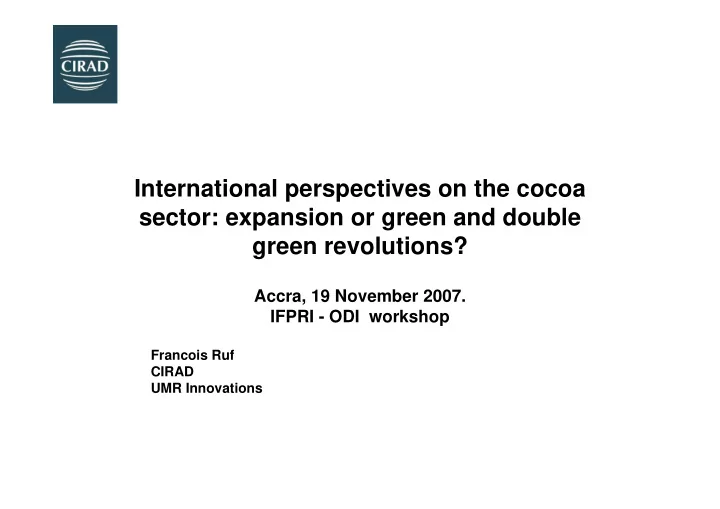

International perspectives on the cocoa sector: expansion or green and double green revolutions? Accra, 19 November 2007. IFPRI - ODI workshop Francois Ruf CIRAD UMR Innovations
Inefficiency of estates and large farms when prices and revenues collapse Cocoa Production per country Brazil and Malaysia. 1970-2004 450 400 350 Thousand of tons 300 250 200 150 100 50 0 1970 1972 1974 1976 1978 1980 1982 1984 1986 1988 1990 1992 1994 1996 1998 2000 2002 2004 Years Malaysia Brazil
Smallholders’ high efficiency and capacity of resistance when prices and revenues collapse Cocoa Production per Country Côte d'Ivoire, Ghana, Indonesia 1975-2004 3000 2500 Thousand of tons 2000 1500 1000 500 0 1975 1977 1979 1981 1983 1985 1987 1989 1991 1993 1995 1997 1999 2001 2003 2005 years
Since 2001, among the three major cocoa producing countries, Ghana displays the most impressive increase in production (compare to the late 1990s) Fig.1 Cocoa Production per Country Côte d'Ivoire, Ghana, Indonesia 1955/56-2005/06 1600 1400 1200 Thousand of to 1000 800 600 400 200 0 1955 1958 1961 1964 1967 1970 1973 1976 1979 1982 1985 1988 1991 1994 1997 2000 2003 years C ôte d'Iv oire G hana Indonesia
This is partially explained by a beginning of ‘green revolution’: new planting material, more pesticides, fungicides and a quite recent adoption of fertilizers. Fertilizer cons umption per cocoa farm in major cocoa producing regions of Soubré (C ôte d'Ivoire) and Mans o A menfi (Ghana) 7 6 number of bags 5 4 3 2 1 0 1996/97 1997/98 1998/99 1999/00 2000/01 2001/02 2002/03 2003/04 years C ôte d'Ivoire G hana
Fertilizers, in particular, have an enormous potential in cocoa farming in West-Africa Production profile of a 5-ha cocoa farm in Soubré hy p 2, w ith fertilizers and pesticides being applied before too m uch m ortality occurs 6000 5000 4000 kg 3000 2000 1000 0 1 2 3 4 5 6 7 8 9 10 11 12 13 14 15 16 17 18 19 20 21 22 23 24 25 26 years
The Cocoa boom in Ghana in the 2000s: a combination of expanding production areas and spectacular yield increases (plus some smuggling from Côte d’Ivoire) Box 1. Expansion and Intensification: estimated breakdown of the increase in cocoa production in Ghana Producing acreage: + 15% Production: +50% Yields per hectare: + 30% Additional +60% production from other countries: + 10% Sources: CIRAD Survey, 2007.
Regular and consistant cocoa yield increase in Ghana in the 2000s Table 15. Changes in cocoa yields per hectare (with the hypothesis of one pole equivalent to 0.90 acre) (a) (b) (c) (d) (e) (f) (E+f)-(a+b) 2001/02 2002/03 2003/04 2004/05 2005/06 2006/07 / (a+b) (in %) Eastern Region 158 208 304 272 316 257 57% Kade Central Region, 259 266 286 298 319 307 19% Hemang Ashanti 181 187 223 164 192 163 -4% Afigya Sekyere Brong Ahafo, 484 512 562 611 692 719 42% Dormaa Wassa Amenfi West (Chichiso 247 265 357 280 383 404 48% Pensanum) Wassa Amenfi 354 314 325 345 362 366 12% West (Obing) Aowin Suaman 430 453 474 480 482 426 3% (Samreboi) Nzema East 554 517 528 612 697 679 20% (Adubrim) All 324 304 369 367 424 417 +7% +14% -1% +16% -2% 34% Increase (n/n-1) Sources: Ruf 2007
This ‘beginning of green revolution’ in Ghana must be moderated if compared to the intensive farming systems in Indonesia but their respective input consumption levels may well be much closer in the next years. Fertilizer cons umption per cocoa farm in major cocoa producing regions of the three main cocoa producing countries 35,0 30,0 number of bags 25,0 20,0 15,0 10,0 5,0 0,0 1996/97 1997/98 1998/99 1999/00 2000/01 2001/02 2002/03 2003/04 years Indonesia C ôte d'Ivoire G hana
Meantime, despite a more modern way of producing cocoa, despite a true green revolution, Indonesia does not escape the sustainability problem Cocoa production profile of 19 farm s in Noling and Tam pum ea 80000 y = -4273,9x + 69260 70000 60000 50000 tonnes 40000 30000 20000 10000 0 2000 2001 2002 2003 2004 2005 2006 years
Hence a need to anticipate externalities of green revolutions by ‘Double Green’ approaches, namely reintroducing biological capital in the systems, especially trees.
What to do with an ageing and declining cocoa farm? Budget sim ulation of a 14-acre cocoa farm (5 to 13 years old in year 1) 2 000 1 800 1 600 Net revenues (US 1 400 1 200 1 000 Cocoa 800 600 400 200 - 1 2 3 4 5 6 7 8 9 10 11 12 13 14 15 16 17 18 19 20 y ears
As seen above, fertilizers can work … but trees can also generate windfalls Budget sim ulation of a 14-acre cocoa farm and im pact of 2.25 acres of teak 10 000 9 000 8 000 Net revenues (US 7 000 6 000 Cocoa 5 000 teak 4 000 3 000 2 000 1 000 - 1 2 3 4 5 6 7 8 9 10 11 12 13 14 15 16 17 18 19 20 y ears
Conclusion 1. Once the forest and ‘forest rent’ have gone, - modern inputs such as fertilizers become and remain extremely useful and absolutely necessary. The extremely recent adoption of fertilizers in West-Africa is a geat achievement in itself - but they have to be combined with organic factors, biological capital, in order to progressively rebuild a ‘post-forest rent’, a key factor in sustainability . 2. Smallholders are certainly brighter than estates to respond to this challenge 3. Eventually, due to demographic pressure and innovations, and if taxation is not to heavy in West-Africa, we will probably see more convergence among cocoa smallholders’ performances in the three continents in the near future
Recommend
More recommend